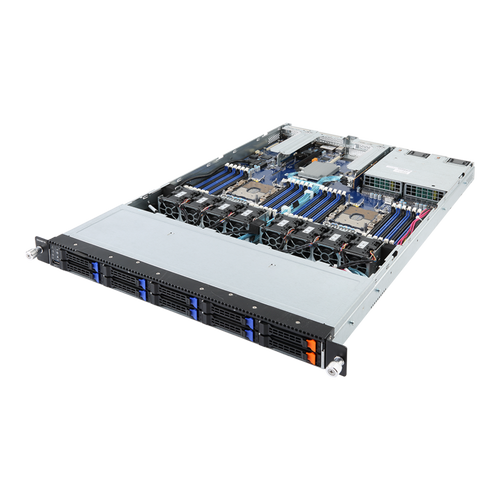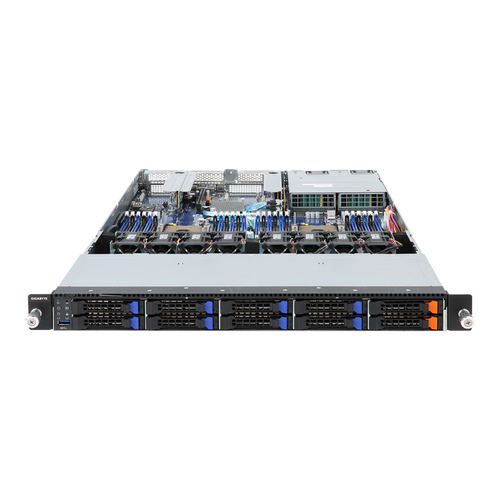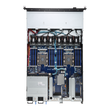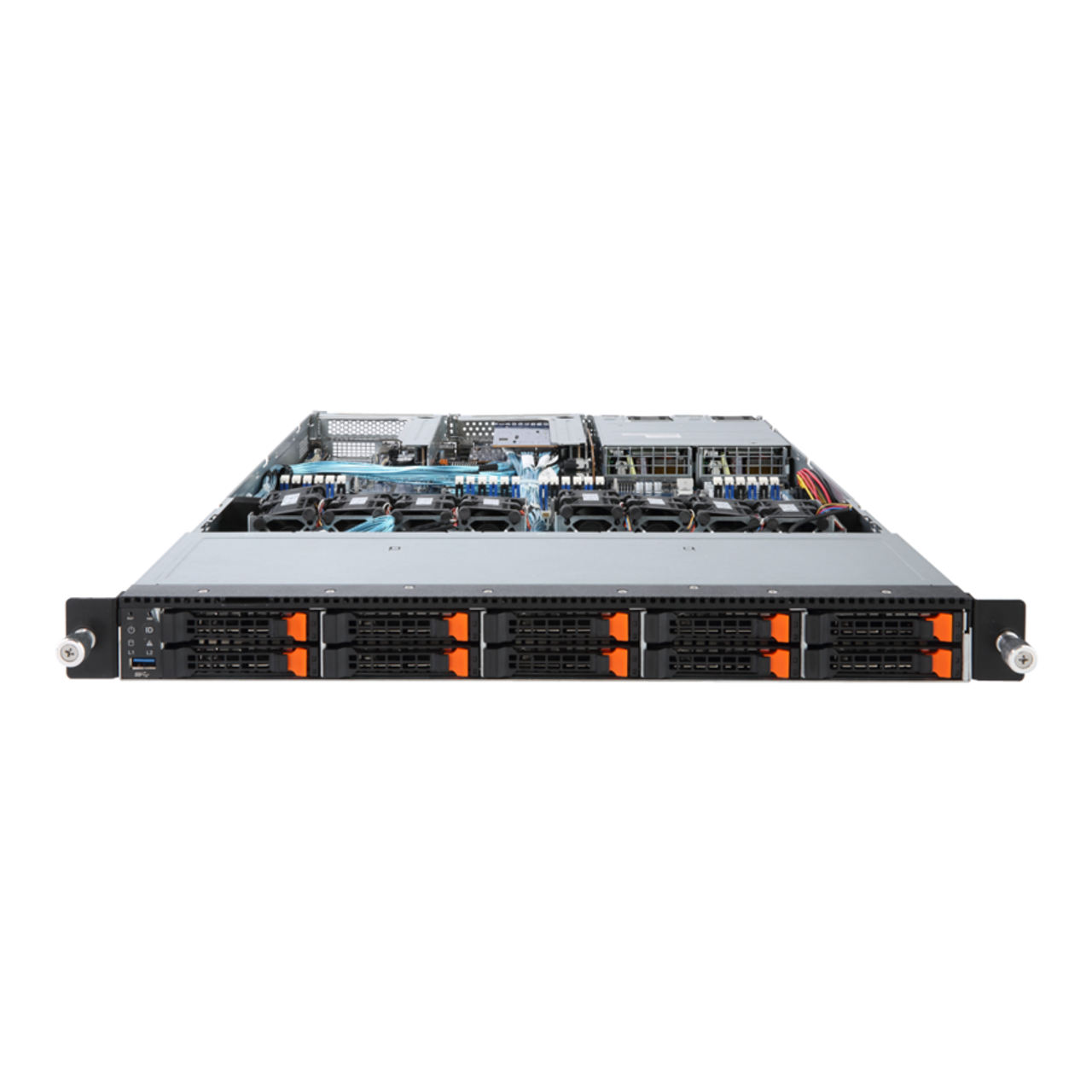Request A Quote
- Availability:
- Vendor Direct Ship | ETA - Request A Quote | Email: sales@hssl.us | Call Us: +1 888 988 5472 |
- Minimum Purchase:
- 54 units

Purchase Protection
Every Order is Protected By BuySafe
Our commitment to sustainability ensures that every purchase supports responsible operations and a healthier planet.
SSL Secure Payment
We make sure your orders are processed as quickly as possible - stocked products are shipped next business day - Vendor direct ship products are processed directly with vendors with vendor leadtime.
Express Shipping
Price Match Guarantee
Your payment is secure
Your privacy and security are our top priority. Our advanced encrypted payment system protects your information during every transaction.

Get expert help
Our team of experienced professionals is always ready to help.
Product Details
- 2nd Gen Intel Xeon Scalable and Intel Xeon Scalable Processors
- Dual processor, LGA 3647
- 6-Channel RDIMM/LRDIMM DDR4, 24 x DIMMs
- Supports Intel Optane DC Persistent Memory
- Dual 1Gb/s LAN port (Intel I350-AM2)
- 1 x Dedicated management port
- 2 x 2.5" Gen3 NVMe/SATA/SAS hot-swappable bays
- 8 x 2.5" SATA/SAS hot-swappable bays
- 3 x LP PCIe Gen3 x16 and x8 slots
- 2 x OCP Gen3 x16 mezzanine slots
- Aspeed AST2500 remote management controller
- Dual 1200W 80 PLUS Platinum redundant power supply
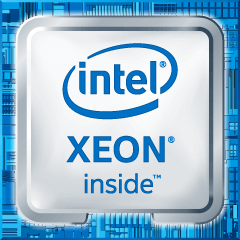
2nd Generation Intel Xeon Scalable Family Ready
GIGABYTE’s servers are fully ready to support the second generation of Intel Xeon Scalable Family processors, codenamed “Cascade Lake”, which bring the following major enhancements:
- Intel Optane™ Persistent Memory: Built-in support for this revolutionary new product based on Intel’s 3D Xpoint technology
- Overall Performance: Higher CPU frequencies, improved turbo profiles vs. prior-gen Intel Xeon Scalable processors
- Increased DDR4 Memory Speed & Capacity: Up to 2933MHz (1 DIMM per channel on some SKUs), 16Gb based DIMM supported
- Intel Deep Learning Boost: Significantly accelerates inference performance for deep learning workloads optimized to use VNNI (Vector Neural Network Instructions)
- Security: Hardware mitigations for Meltdown / Spectre security vulnerabilities
Intel Xeon Scalable Family Processors
GIGABYTE’s Intel Xeon Scalable Processor family servers are available in dual socket configurations, and are compatible with the full family of different SKUs (Bronze, Silver, Gold and Platinum) that are workload optimized to support different applications, from enterprise IT database, cloud and storage to the most high-demand HPC workloads.
* SKU compatibility will depend on the maximum CPU TDP supported for each system, please refer to each product’s specification page for further information

Advanced features built into the silicon include:
- Intel QAT: Speed up data compression and cryptography with integrated Intel QuickAssist Technology (QAT).
- Intel AVX-512: Intel Advanced Vector Extension 512 instruction set architecture enables workload-optimized performance and throughput increases for advanced analytics, high performance computing (HPC) applications, and data compression.
- Intel VROC: Intel Xeon Scalable Processors come with built-in support for Intel VROC (Virtual RAID on CPU). And Gigabyte Intel Xeon Scalable NVMe SKU servers all ship with an Intel VROC module as standard.
- Intel Omni-Path: Selected Gigabyte servers support CPU SKUs with integrated Intel Omni-Path Fabric connection
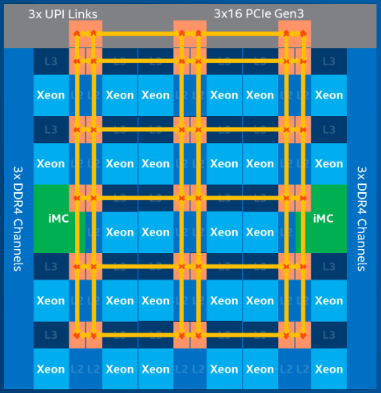
Compute
Memory
I/O
Intel Optane Persistent Memory Ready
GIGABYTE’s second generation Intel Xeon Scalable family servers come ready to support Intel Optane™ Persistent Memory, a revolutionary new product that re-defines traditional memory & storage architectures by enabling a large persistent memory tier between DRAM and SSDs, that’s higher capacity than DRAM and faster than SSDs, enabling the user to bring more data closer to the CPU for faster time for insight.
Optane Persistent Memory Modules (“PMem”) integrate seamlessly into existing DDR4 DIMM slots, and use Intel’s 3D Xpoint memory technology, which unlike DRAM retains data after power is removed. The modules will be available in capacities up to 512GB – a massive increase compared to the current maximum 128GB of industry-leading DDR4 memory sticks – and can be addressed by the OS or application either as memory (Memory Mode) or storage (Application Direct Mode).
Note: the maximum number of Intel® Optane™ PMem that can be installed per system and the DIMM slot positions that can be used for PMem will vary according to each server model due to thermal considerations. Please refer to each product’s specification page for further instructions.
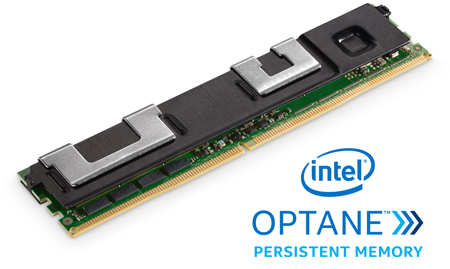

Intel® VROC Enabled
This server product is enabled for Intel VROC (Virtual RAID on CPU) to enable software RAID on connected Intel NVMe SSDs.

R181-N20 Product Overview
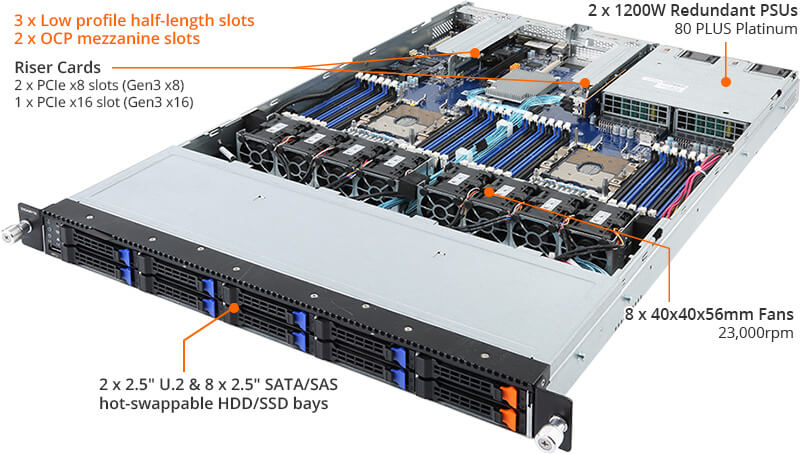
R181-N20 Block Diagram
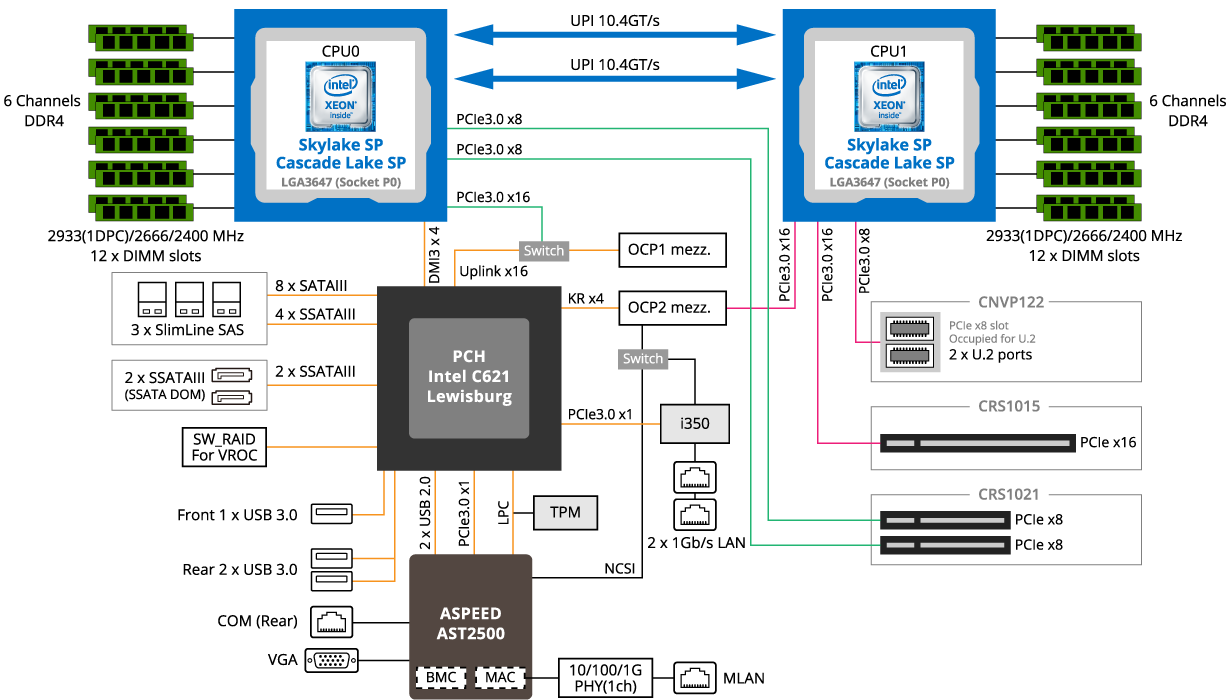
Dense Add-On Slot Design
Gigabyte brings you the most comprehensive add-on slot options available: Low Profile/ OCP/ Full Height Half Length/ Full Height Full Length

3 x Low Profile & 2 x OCP in 1U

3 x Full Height Full Length & 5 x Full Height Half Length & 2 x OCP in 2U

6 x Full Height Half Length & 2 x Low Profile & 2 x OCP in 2U
Optimized for High TDP
Gigabyte systems are thermally designed with the highest rated CPU SKUs in mind so that top performance is enabled which ever Xeon Scalable CPU you choose.

Carefully Selected Components
GIGABYTE’s passive components are carefully selected to guarantee a stable operating environment and allow the processors and the memory to deliver their maximum performance. GIGABYTE’s server motherboards are built with long lasting components for a high degree of reliability and durability.

Ease of Deployment and Management
Gigabyte continues to be responsive to market needs and to create user-friendly solutions, including:
- Tool-less rail kit included as a default across all new server models
- Supplying multiple connector options and tools where appropriate
Efficient, Reliable Power Supply
Gigabyte SERVER Xeon Scalable servers are designed to guarantee high conversion efficiency regardless of load. Redundant 80 Plus ‘Titanium’ or ‘Platinum’ PSUs, combined with GIGABYTE’s precision engineering, translates to super efficient power usage which maximizes the system’s power : performance ratio and reduces OPEX for the user.

Intelligent Power Management Features
Cold Redundancy
To take advantage of the fact that a PSU will run at greater power efficiency with a higher loading, Gigabyte has introduced a power management feature called Cold Redundancy for servers with dual PSU. When the total system loading falls lower than 40%, the system will automatically place one PSU into standby mode, enabling the other PSU to take over the greater load. This can enable total system power efficiency savings of up to 10%.

System Power Efficiency
SCMP (Smart Crises Management / Protection)
SCMP is a Gigabyte patented feature that will automatically force the system’s CPU to enter ULFM (ultra-low frequency mode for minimum power consumption) when the BMC is alerted to a PSU fault or error (such as power loss, power surge, overheating or a fan problem). This feature will prevent shutdown in systems with less than 1 + 1 PSU redundancy when one PSU is lost. In a 2U 4 Node server, only two nodes will be switched to low power mode, while two remaining nodes can continue normal operation. When the fault is resolved or the PSU is replaced, the system will automatically return to normal power mode.
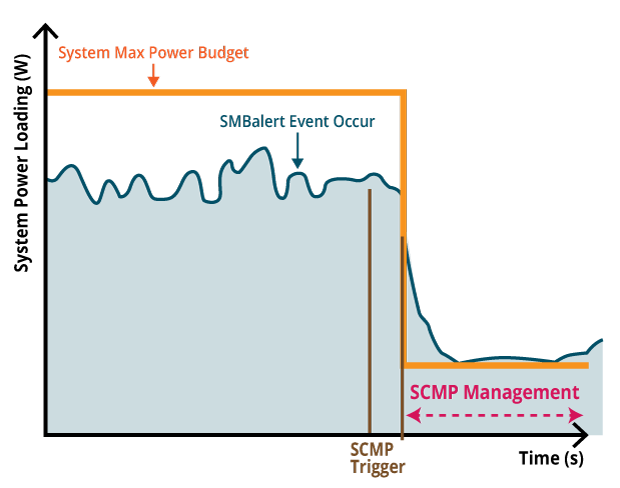
System Loading Curve
Gigabyte Server Management (GSM)
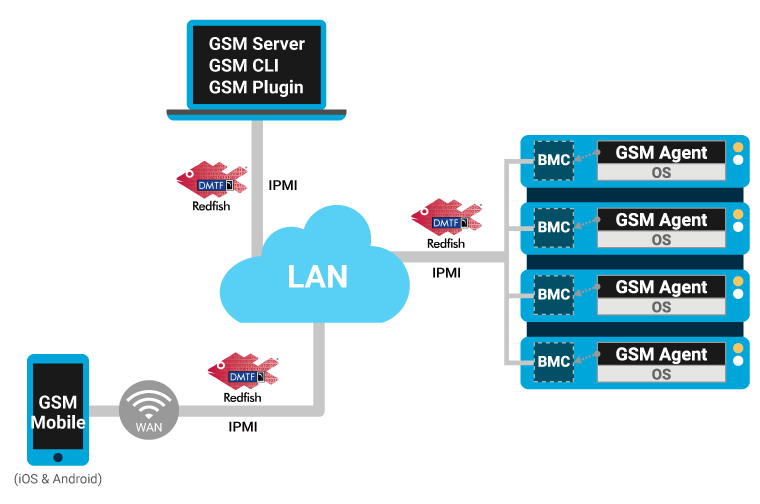
Gigabyte Server Management (GSM) is GIGABYTE’s proprietary multiple server remote management software platform, available as a free download from each Gigabyte server product page. GSM is compatible with either IPMI or Redfish connection interfaces, and comprises the following sub-programs:
- GSM Server
A software program with an easy to use browser-based GUI to enable global remote monitoring and management of multiple Gigabyte servers via each server node’s BMC. - GSM CLI (GBT Utility)
A command-line interface program to enable global remote monitoring and management of multiple Gigabyte servers via each server node’s BMC. - GSM Agent
A software program installed locally on each Gigabyte server node that retrieves additional node information (CPU/Mem/HDD/PCI/…) from the OS and passes it to the BMC. This information can then be utilized by GSM Server or GSM CLI. - GSM Mobile
A remote server management mobile APP, available for both Android and iOS. - GSM Plugin
A plugin that allows the user to manage and monitor Gigabyte server nodes within VMware’s vCenter.
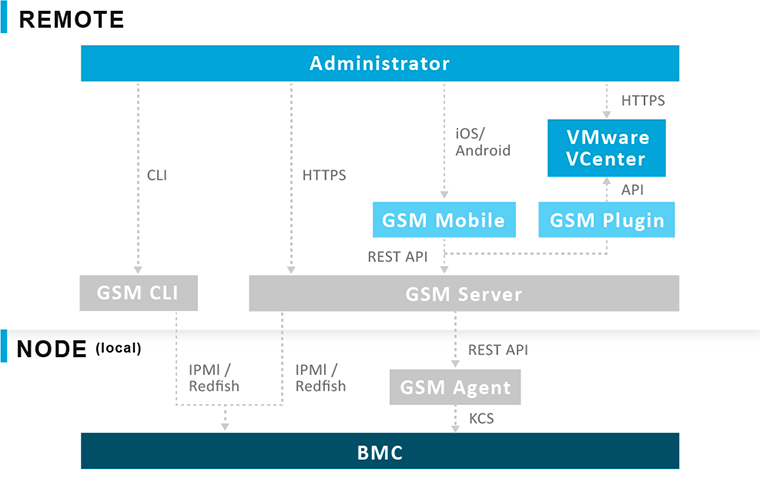
Intuitive & Informative User Interface
Starting from the GSM Server dashboard, the user can clearly understand the status of each node in the IT environment, including:
- Node connection status (system is online/offline)
- Node hardware sensor status (to detect hardware anomalies). Sensors measure voltage, fan speed and temperature
- Node usage rate status (allowing you to timely allocate more resources when they are needed), including:
- Power consumption
- Disk/RAID usage information
- Memory usage rate
- CPU usage rate
- Network card / PCI information
The user can also perform various management functions, including:
- Node remote access
- Power on / off / reset
- Launch iKVM
- Reboot BMC / BMC Account Configuration
- Network Configuration
- IPv4/IPv6 setting
- Alert Management
- SNMP trap setting
- Platform events filters
- Forwarding alerts by email
- BMC / BIOS / CPLD Update
- Power Consumption Limit Setting
- Group Management
- Create groups of nodes for BMC / BIOS update or manage power consumption settings
Shipping & Return
Return Policy
You need to have a Return Authorization (RA) number before returning any products to HSSL Technologies.
For a hard copy of this form and a shipping label, please include your request in the form below.
You can also request an RA online by submitting an RA Request via email. Once you have provided HSSL Technologies with the appropriate information, we will contact you with an assigned RA number.
Defective or DOA Products
DOA or defective products are returned for REPLACEMENT ONLY with the same product/model. Deviations from this policy may result in a 20% Returns Processing Service Charge.
- Defective products must be in the original factory carton with all original packing materials.
- The Return Authorization number must be on the shipping label, not the carton. Please do not write on the carton.
- Returns must be shipped freight prepaid. Products received freight collect, without an RA number, or not approved for return will be refused.
- Return Authorization numbers are valid for fourteen (14) days only. Products returned after expiration will be refused.
- HSSL credits are based on the purchase price or current price, whichever is lower.
General Return Terms
You may return most new, unopened items within 30 days of delivery for a full refund. We will also pay return shipping costs if the return is a result of our error (e.g., you received an incorrect or defective item).
You should expect to receive your refund within approximately six weeks of giving your package to the return shipper. This period includes:
- 5–10 business days for us to receive your return from the shipper
- 3–5 business days for us to process your return
- 5–10 business days for your bank to process the refund
If you need to return an item, please Contact Us with your order number and product details. We will respond quickly with instructions for returning items from your order.
Shipping Policy
We can ship to virtually any address in the world. Note that there are restrictions on some products, and certain products cannot be shipped to international destinations.
When you place an order, we will estimate shipping and delivery dates based on the availability of your items and the shipping options you select. Depending on the provider, estimated shipping dates may appear on the shipping quotes page.
Please also note that shipping rates for many items are weight-based. The weight of each item can be found on its product detail page. To reflect the policies of the shipping companies we use, all weights will be rounded up to the next full pound.
Has my order shipped?
Click the "My Account" link at the top right hand side of our site to check your orders status.
How do I change quantities or cancel an item in my order?
Click the "My Account" link at the top right hand side of our site to view orders you have placed. Then click the "Change quantities / cancel orders" link to find and edit your order. Please note that once an order has begun processing or has shipped, the order is no longer editable.
How do I track my order?
Click the "My Account" link at the top right hand side of our site to track your order.
My order never arrived.
Click the "My Account" link at the top right hand side of our site to track your order status. Be sure that all of the items in your order have shipped already. If you order displays your Package Tracking Numbers, check with the shipper to confirm that your packages were delivered. If your packages each show a status of "delivered", please contact customer service for assistance.
An item is missing from my shipment.
Click the "My Account" link at the top right hand side of our site to track your order status. Be sure that all of the items in your order have shipped already. If you order displays your Package Tracking Numbers, check with the shipper to confirm that your packages were delivered. If your packages each show a status of "delivered", please contact customer service for assistance.
My product is missing parts.
Click the "My Account" link at the top right hand side of our site to track your order status. Be sure that all of the items in your order have shipped already. If you order displays your Package Tracking Numbers, check with the shipper to confirm that your packages were delivered. If your packages each show a status of "delivered", please contact customer service for assistance.
When will my backorder arrive?
Backordered items are those which our suppliers are unable to predict when they will have more in stock, but as soon as they do, we will be able to ship the item to you.
Warranty
Why Choose HSSL?
We connect businesses with the right technology solutions to power growth, security, and efficiency.

Expertise
Backed by years of industry knowledge, our specialists understand the challenges modern businesses face.

Partnerships
We collaborate with top-tier technology providers to bring you innovative & high-performance products.

End-to-End Support
Our dedicated support ensures your systems stay optimized, secure, and ready for what’s next.

Scalable Solutions
Our adaptive approach ensures your IT infrastructure evolves seamlessly as your business expands.
Expert in IT & Security Solutions
At HSSL, we specialize in delivering cutting-edge IT infrastructure, cloud, and cybersecurity services that empower businesses to thrive in a digital-first world. Our trusted professionals provide reliable insights on:
-
Digital Transformation Strategy
Empowering businesses to adapt and grow through modern, secure, and scalable digital infrastructure.
-
Advanced Cybersecurity
Protecting your organization from digital threats with proactive monitoring and smart security frameworks.
-
Cloud & Infrastructure Management
Optimizing cloud performance and IT operations for seamless scalability and improved business agility.
-
Data Backup & Recovery
Ensuring business continuity through secure data management, automated backups, and rapid recovery solutions.
-
Network & Endpoint Solutions
Delivering secure, high-performance networking systems that keep your business connected and efficient.
-
Technology Consulting
Guiding organizations toward smarter IT investments and solutions that align with their long-term goals.

